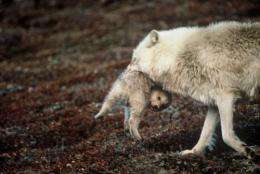North Pole wolf emails locations to researchers

In July the scientists, one from the United States, the other from Canada, put the satellite collar on Brutus, the leader of his wolf pack, on remote Ellesmere Island, only 600 miles from the North Pole. Their goal - to finally find out what these "North Pole wolves" do in the long, dark days of winter in one of the harshest areas of the world.
"We first encountered 9-year-old Brutus back in 2003," said David Mech, a renowned U.S. Geological Survey (USGS) wolf researcher who has been studying the Ellesmere Island wolves for the last 24 years. That is, he's followed them during summer, which is pretty much the month of July. Snow begins falling in August, and except for June, that fleeting month of arctic spring, at most other times it is nearly impossible for people to travel to the island or withstand the cold temperatures.
"This year, we made a huge technological jump from notebook and pens to satellite collars because we wanted to find out what these arctic wolves do in winter in areas when it is dark 24 hours a day and temperatures can fall to -70 degrees Fahrenheit," Mech said. "How far must they travel to obtain enough food to make it to the Arctic spring, which doesn't happen until the next June?"
If the high-tech collars can withstand these temperatures, Mech and his colleague, Canadian researcher Dean Cluff, can sit in total comfort in their offices far to the south and find out via emails from Brutus. As Mech admits, it's quite a difference from the harsh and often-sleepless conditions the researchers are used to in the field.
When Mech first visited Ellesmere Island in 1986, he found that the wolves there were tame because of few to no interactions with people. Since then, the wolf researcher has taken advantage of this unusual research opportunity to uncover facets of wolf behavior and ecology that can't be learned anywhere else.
This information supplements his other wolf research during the rest of the year in areas like Minnesota and Yellowstone National Park. Mech's life work on wolves has been instrumental in unraveling the little-known daily world of wolves. Ultimately, it has also helped resource managers better understand the complex nature of wolf ecology and management, including the challenging task of managing wolf-livestock interactions.
Brutus is an imposing 90-pound wolf, who sports a lionish ruff and that new satellite collar around his neck. Like all arctic wolves, Brutus is mostly white or light in color, and has long, coltish legs superbly suited for his long-distance jaunts and major hunting forays. And, says Mech, he's not afraid to keep his pack of at least 12 adults and 6-12 pups in line.
Brutus' collar collects and stores 2 locations per day, obtained via Global Positioning Satellites (GPS). Every 4 days the collar uploads the data to ARGOS satellites that email Brutus' location at a particular time and date to the researchers' computers. Unlike the VHF radio collar, which is still widely used to locate animals and birds, the GPS collar "listens" to the signal from a constellation of satellites and can calculate, by triangulating its own location, precisely where the animal is.
Since the researchers left Ellesmere, the wolf has "emailed" 145 locations to Mech and Cluff. So far, Brutus and his pack have covered an area of 740 square miles. And, said Mech, one day recently, Brutus traveled about 21 miles (straight-line distance) in no more than 12 hours. "He no doubt went around steep Blacktop Mountain, which would have required travel of much more than 21 miles, and all this in 12 hours max," explained Mech. "While not unheard of, this long travel is still impressive."
From their fieldwork, the men also know the pack preys almost exclusively on muskoxen and arctic hares, and that it has an unknown number of growing pups as well. An early hard winter, said Mech, could mean no hare and muskoxen reproduction next year, which would mean less wolf food in the future.
Recent downloads of satellite data also indicate probable sites of muskox kills. "With a recent download, I noticed that Brutus - and probably several other pack members - had traveled to the north side of a fiord to an area frequented by muskoxen, about 25 miles north of where the pups are. Because the locations are precise to within a few yards or meters, next summer we will use hand-held GPS units to check these sites for bones," Mech said.
Brutus' recent movement make the researchers also suspect that the wolves have moved this year's pups to a new rendezvous site near some river flats. Pups are usually kept at these rendezvous sites until they reach adult size and can travel with the rest of the pack. In more southern areas, this occurs in about October, but in the arctic, researchers don't know when that occurs.
"We eagerly await Brutus' signal to give us that information," Mech said.
Source: United States Geological Survey (news : web)















